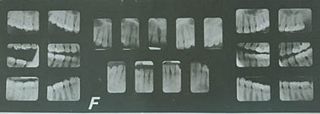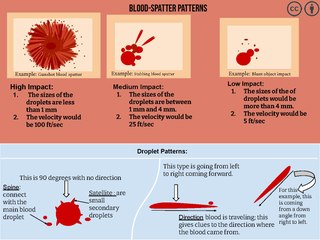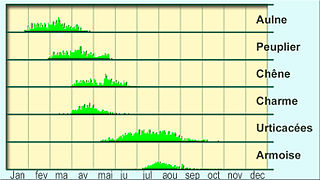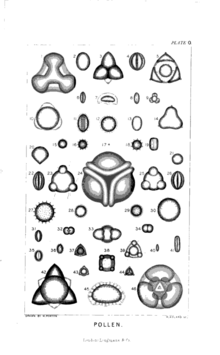
DNA profiling is the process of determining an individual's deoxyribonucleic acid (DNA) characteristics. DNA analysis intended to identify a species, rather than an individual, is called DNA barcoding.

Pollen is a powdery substance produced by most types of flowers of seed plants for the purpose of sexual reproduction. It consists of pollen grains, which produce male gametes. Pollen grains have a hard coat made of sporopollenin that protects the gametophytes during the process of their movement from the stamens to the pistil of flowering plants, or from the male cone to the female cone of gymnosperms. If pollen lands on a compatible pistil or female cone, it germinates, producing a pollen tube that transfers the sperm to the ovule containing the female gametophyte. Individual pollen grains are small enough to require magnification to see detail. The study of pollen is called palynology and is highly useful in paleoecology, paleontology, archaeology, and forensics. Pollen in plants is used for transferring haploid male genetic material from the anther of a single flower to the stigma of another in cross-pollination. In a case of self-pollination, this process takes place from the anther of a flower to the stigma of the same flower.

Palynology is the study of microorganisms and microscopic fragments of mega-organisms that are composed of acid-resistant organic material and occur in sediments, sedimentary rocks, and even some metasedimentary rocks. Palynomorphs are the microscopic, acid-resistant organic remains and debris produced by a wide variety plants, animals, and Protista that have existed since the late Proterozoic.

Forensic dentistry or forensic odontology involves the handling, examination, and evaluation of dental evidence in a criminal justice context. Forensic dentistry is used in both criminal and civil law. Forensic dentists assist investigative agencies in identifying human remains, particularly in cases when identifying information is otherwise scarce or nonexistent—for instance, identifying burn victims by consulting the victim's dental records. Forensic dentists may also be asked to assist in determining the age, race, occupation, previous dental history, and socioeconomic status of unidentified human beings.

Micropaleontology is the branch of paleontology (palaeontology) that studies microfossils, or fossils that require the use of a microscope to see the organism, its morphology and its characteristic details.

Hair analysis may refer to the chemical analysis of a hair sample, but can also refer to microscopic analysis or comparison. Chemical hair analysis may be considered for retrospective purposes when blood and urine are no longer expected to contain a particular contaminant, typically three months or less.

The post-mortem interval (PMI) is the time that has elapsed since an individual's death. When the time of death is not known, the interval may be estimated, and so an approximate time of death established. Postmortem interval estimations can range from hours, to days or even years depending on the type of evidence present. There are standard medical and scientific techniques supporting such an estimation.
Forensic identification is the application of forensic science, or "forensics", and technology to identify specific objects from the trace evidence they leave, often at a crime scene or the scene of an accident. Forensic means "for the courts".

Bloodstain pattern analysis (BPA) is a forensic discipline focused on analyzing bloodstains left at known, or suspected crime scenes through visual pattern recognition and physics-based assessments. This is done with the purpose of drawing inferences about the nature, timing and other details of the crime. At its core, BPA revolves around recognizing and categorizing bloodstain patterns, a task essential for reconstructing events in crimes or accidents, verifying statements made during investigations, resolving uncertainties about involvement in a crime, identifying areas with a high likelihood of offender movement for prioritized DNA sampling, and discerning between homicides, suicides, and accidents.

Forensic biology is the application of biological principles and techniques in the investigation of criminal and civil cases.

Forensic geology is the study of evidence relating to materials found in the Earth used to answer questions raised by the legal system.

A pollen calendar is used to show the peak pollen times for different types of plant pollen, which causes allergic reactions in certain people.

Forensic geophysics is a branch of forensic science and is the study, the search, the localization and the mapping of buried objects or elements beneath the soil or the water, using geophysics tools for legal purposes. There are various geophysical techniques for forensic investigations in which the targets are buried and have different dimensions. Geophysical methods have the potential to aid the search and the recovery of these targets because they can non-destructively and rapidly investigate large areas where a suspect, illegal burial or, in general, a forensic target is hidden in the subsoil. When in the subsurface there is a contrast of physical properties between a target and the material in which it is buried, it is possible to individuate and define precisely the concealing place of the searched target. It is also possible to recognize evidences of human soil occupation or excavation, both recent and older. Forensic geophysics is an evolving technique that is gaining popularity and prestige in law enforcement.

Forensic statistics is the application of probability models and statistical techniques to scientific evidence, such as DNA evidence, and the law. In contrast to "everyday" statistics, to not engender bias or unduly draw conclusions, forensic statisticians report likelihoods as likelihood ratios (LR). This ratio of probabilities is then used by juries or judges to draw inferences or conclusions and decide legal matters. Jurors and judges rely on the strength of a DNA match, given by statistics, to make conclusions and determine guilt or innocence in legal matters.
Professor Patricia Wiltshire is a forensic ecologist, botanist and palynologist. She has been consulted by police forces and industry in almost 300 investigations in several countries and has been instrumental in solving several high-profile crimes, including the killings of Sarah Payne and Millie Dowler, the cold case of Christopher Laverack, the Soham murders, and the Ipswich serial murders.

Forensic mycology is the use of mycology in criminal investigations. Mycology is used in estimating times of death or events by using known growth rates of fungi, in providing trace evidence, and in locating corpses. It also includes tracking mold growth in buildings, the use of fungi in biological warfare, and the use of psychotropic and toxic fungus varieties as illicit drugs or causes of death.

Ear print analysis is used as a means of forensic identification intended as an identification tool similar to fingerprinting. An ear print is a two-dimensional reproduction of the parts of the outer ear that have touched a specific surface. Ear prints and their use for identification were first discovered by Fritz Hirschi in 1965. Fritz Hirschi was the first to identify a criminal using this method, in Switzerland in 1965 and ear print analysis has also been successfully used to solve crimes in the UK and the Netherlands. In addition to identification, the height of an ear imprint at a crime scene may also provide investigators with information regarding the stature of the perpetrator.
Sophie Warny is a Belgian Antarctic researcher, best known for her work on palynology. As an associate professor at Louisiana State University in the Department of Geology and Geophysics and one of the curators at the Museum of Natural Science, Warny studies past climate change patterns by examining fossilized pollen and spores. She is currently the vice president of the Gulf Coast Section of the Society for Sedimentary Geology (GCSSEPM).
Candice Mae Bridge is an American chemist and Associate Professor of Chemistry and Forensic Science at the University of Central Florida. Her research considers the development of mass spectroscopy for forensic analysis, including the characterization of lubricant from rape victims and residue from gunshots, as well as the identification of drugs in urine samples.

Forensic colorimetry, or forensic color analysis, is the examination of specimen color for purposes of forensic investigation. Typical specimens involved in color analyses include pigments, dyes, or other objects that are distinguishable by their intrinsic color. Analyses may be conducted by-eye or by computational methods, both by matching specimen colors to a standardised chart or database.













